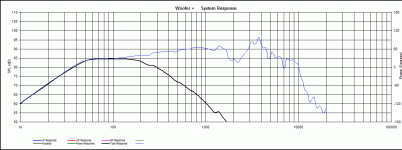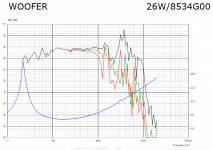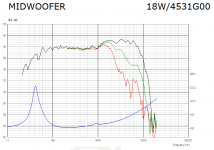Take a look at the OUT wires. Post #24 , first row, third photo.
Post #15 indicates a passive radiator was put into use ( after dumping a ported version ) .
Post #15 indicates a passive radiator was put into use ( after dumping a ported version ) .

Indeed it was!
edit: now it looks like there is two probable solutions to resolving the issue. Either make some more room for a single woofer+PR to lower the Fb as much as possible and tune the woofer accordingly or seal the extra apertures and turn it into a closed cabinet, boosting the bass response with the aid of dsp.
Last edited:
It's not clear to me that this is a Troels design, or a design by the OP, inspired by designs on Troels website.So one other question. Troels usually designs with a lot of damping material. I don't see any in these pics, has this changed??
A passive filter solution would have looked like this for a single woofer and a PR. I have observed it from the pictures and it looks as it was a Dayton Audio SD 270 so I've simulated it tuned to Fb=30 Hz (22 g additional weight) in a 55 lit box and added an RCL to smooth the impedance peak of the woofer with a simple 2nd order LP. The end result is F3/F6/F10 43/33/26 Hz. That is as good as it gets with this combination. Impedance is steady at 5 ohms.
Attachments
Lot of waffle in this thread, IMO. Leading nowhere... 
This apparently is what we have:
Scanspeak
R2904-700000 tweeter-4
18W/4531G00 midrange-4
26W/8534G00-8
Cabinet
Lower bass 55 liter. (Plus ABR.)
Upper tweeter/midbass 21 liter.
Let's get focussed here. A Qts=0.40 bass driver looks OK in 55L closed box to me.
The 90dB Le 0.9mH 10" bass is actually something I wouldn't touch with a bargepole. A metal driver. All that breakup to deal with! You can see it!
The 90dB Le 0.3mH 6-7" mid is quite flat and gentle in response. If it was 8 ohms I would love it.
Tweeter, as I said, is not ideal here for the necessary low crossover with 6-7" mid around 2.5-2.8kHz.
Unless we see the crossover, there is no point of departure here to rescue this speaker. IMO, half the skill of a good speaker is selecting drive units that play nicely together. I do think a gutsier tweeter like a SB acoustics that can dig low might let everything fall into place here.
This apparently is what we have:
Scanspeak
R2904-700000 tweeter-4
18W/4531G00 midrange-4
26W/8534G00-8
Cabinet
Lower bass 55 liter. (Plus ABR.)
Upper tweeter/midbass 21 liter.
Let's get focussed here. A Qts=0.40 bass driver looks OK in 55L closed box to me.
The 90dB Le 0.9mH 10" bass is actually something I wouldn't touch with a bargepole. A metal driver. All that breakup to deal with! You can see it!
The 90dB Le 0.3mH 6-7" mid is quite flat and gentle in response. If it was 8 ohms I would love it.
Tweeter, as I said, is not ideal here for the necessary low crossover with 6-7" mid around 2.5-2.8kHz.
Unless we see the crossover, there is no point of departure here to rescue this speaker. IMO, half the skill of a good speaker is selecting drive units that play nicely together. I do think a gutsier tweeter like a SB acoustics that can dig low might let everything fall into place here.
Attachments
Your first mistake was getting a 6" 4 ohm midrange, which will cause some severe low impedance issues.
@system7: How does that happen? I have read it before, but don't understand why. I want to do the same thing to match sensitivity of 8R woofer and 4R tweeter. Thank you, Rich
@system7: How does that happen? I have read it before, but don't understand why. I want to do the same thing to match sensitivity of 8R woofer and 4R tweeter. Thank you, Rich
Steve is usually not given to hyperbole, but in this case he has left me scratching my head too. I have that 6.5" driver. Minimum impedance was 4 Ohms. That's fine.
The 4 Ohm mid-woofer is 3 dB more sensitive than the 8 Ohm counterpart so you'll probably have to pad the tweeter down less than you would otherwise. This is overall a good thing, but of course, this is a three way..... so at the end of the day all 3 drivers must match in terms of sensitivity.
There's no reason to match impedance of your drivers so long as your final result is an amplifier friendly load. The 18W/4531 is fine.
Best,
E
Well, 4 Ω is half of 8 Ω ! The amplifier sees low Z and pumps current, and reactance introduced by passive components together with the speaker might cause the power devices to die ! With a 2 way speaker that not might be a problem as the woofer makes the major job and the components number is relatively low
Hey Pico!
Most decent amps solid state amps can handle 4 Ohms, no problem! And many good tube amps can handle this at a low phase angle as well.
With a 3 way crossover the impedance of the drivers does not actually parallel. That is, with 3 x 8 Ohm drivers you don't end up with a minimum impedance of 8/3 = 2 2/3 Ohm! The minimum impedance is usually the minimum impedance of the lowest impedance driver, though this can change with EQ circuits, etc. but I don't see a problem necessarily with using a 4 Ohm midrange in a 3 way speaker.
Let me know and I can point you to a blog post with simulation files so you can learn more about it.
Best,
E
Most decent amps solid state amps can handle 4 Ohms, no problem! And many good tube amps can handle this at a low phase angle as well.
With a 3 way crossover the impedance of the drivers does not actually parallel. That is, with 3 x 8 Ohm drivers you don't end up with a minimum impedance of 8/3 = 2 2/3 Ohm! The minimum impedance is usually the minimum impedance of the lowest impedance driver, though this can change with EQ circuits, etc. but I don't see a problem necessarily with using a 4 Ohm midrange in a 3 way speaker.
Let me know and I can point you to a blog post with simulation files so you can learn more about it.
Best,
E
Last edited:
It is harder to keep the impedance benign around the xover points and in the midrange bandwidth if the driver is a 4 ohm load. I'm not saying it's not possible, but when other circuits are required to keep the FR in check or the phase aligned, sometimes you end up with a lower impedance than expected, just because the mid is 4 ohms to start with. If the mid needs padded, then a series resistor is really all it takes to try and fix the issue of low impedance magnitude. In a 2-way, the 4 ohm midbass is less of a concern than having more drivers overlap and xover to each other on both extremes of said driver.
Later,
Wolf
Later,
Wolf
Lot of waffle in this thread, IMO. Leading nowhere...
This apparently is what we have:
Scanspeak
R2904-700000 tweeter-4
18W/4531G00 midrange-4
26W/8534G00-8
Cabinet
Lower bass 55 liter. (Plus ABR.)
Upper tweeter/midbass 21 liter.
Let's get focussed here. A Qts=0.40 bass driver looks OK in 55L closed box to me.
The 90dB Le 0.9mH 10" bass is actually something I wouldn't touch with a bargepole. A metal driver. All that breakup to deal with! You can see it!
The 90dB Le 0.3mH 6-7" mid is quite flat and gentle in response. If it was 8 ohms I would love it.
Tweeter, as I said, is not ideal here for the necessary low crossover with 6-7" mid around 2.5-2.8kHz.
Unless we see the crossover, there is no point of departure here to rescue this speaker. IMO, half the skill of a good speaker is selecting drive units that play nicely together. I do think a gutsier tweeter like a SB acoustics that can dig low might let everything fall into place here.
Going on commentary here....
It would seem that the 6" mid @ 4ohm is causing a lot of raised eyebrows. Possibly swap that for a 4" component?
Run the woofer sealed and well stuffed?
If there is a low impedance issue for the amplifier simply wire a 2.2 ohm resistor in series with the loudspeaker and compensate the loss with an increase in the volume from the amplifier.
Damping factor concerns are usually bunkcome anyway as the voice resistance + series resistance of any inductances will minimise the damping factor of the amplifier as it is.
C.M
Damping factor concerns are usually bunkcome anyway as the voice resistance + series resistance of any inductances will minimise the damping factor of the amplifier as it is.
C.M
Just wanted to say it is not 7 months of failure it is 7 months of learning  My MTM's took me over 6 (5 years to get to the point where they could play any music) years to finish, and at least three iterations of the crossovers before I was happy. getting from OK to great is a learning experience in itself. Don't beat yourself up if it doesn't knock your sox off from day one
My MTM's took me over 6 (5 years to get to the point where they could play any music) years to finish, and at least three iterations of the crossovers before I was happy. getting from OK to great is a learning experience in itself. Don't beat yourself up if it doesn't knock your sox off from day one 
Even if at the end of the day it doesn't live up to your expectations it is still not a failure, it is an achievement! The most important thing is to work out why it doesn't work as well as you hoped, and then either remedy it, or if all else fails start again avoiding mistakes you made the first time.
Tony.
Even if at the end of the day it doesn't live up to your expectations it is still not a failure, it is an achievement! The most important thing is to work out why it doesn't work as well as you hoped, and then either remedy it, or if all else fails start again avoiding mistakes you made the first time.
Tony.
Last edited:
The 6.5" is a head scratcher, but not killer. I'm pretty confident I could make it work well!  But I wouldn't have started with it, as it requires more of the tweet.
But I wouldn't have started with it, as it requires more of the tweet.
Need to see entire the entire sim. The poor OP has already gone through a lot, let's not start having him spin with new parts and designs just yet.
Best,
E
Need to see entire the entire sim. The poor OP has already gone through a lot, let's not start having him spin with new parts and designs just yet.
Best,
E
Don't worry about it - it may well be down to the passive crossovers anyway - they are terrible for audio quality. Use some good actives and they'll be far better if done right.
The whole active/passive argument has been addressed many times at DIYAudio. I won't rehash it, but I see challenges either way.
I'm quite satisfied with my passive xover and the system's simplicity. Whatever the OP's problem is, I think measurements are the first place to start.
Best,
E
Just FYI, I have a couple of designs with the mid-woofer, 18W/4531 and some pretty pricey tweets.
One real, one virtual as I relied on a vendor's tweeter data but never built it.
I was able to cross this over up to around 1.8kHz fairly easily. With a notch filter it could probably go up to 2 kHz.
One real, one virtual as I relied on a vendor's tweeter data but never built it.
I was able to cross this over up to around 1.8kHz fairly easily. With a notch filter it could probably go up to 2 kHz.
- Status
- This old topic is closed. If you want to reopen this topic, contact a moderator using the "Report Post" button.
- Home
- Loudspeakers
- Multi-Way
- 7 months of failure.


